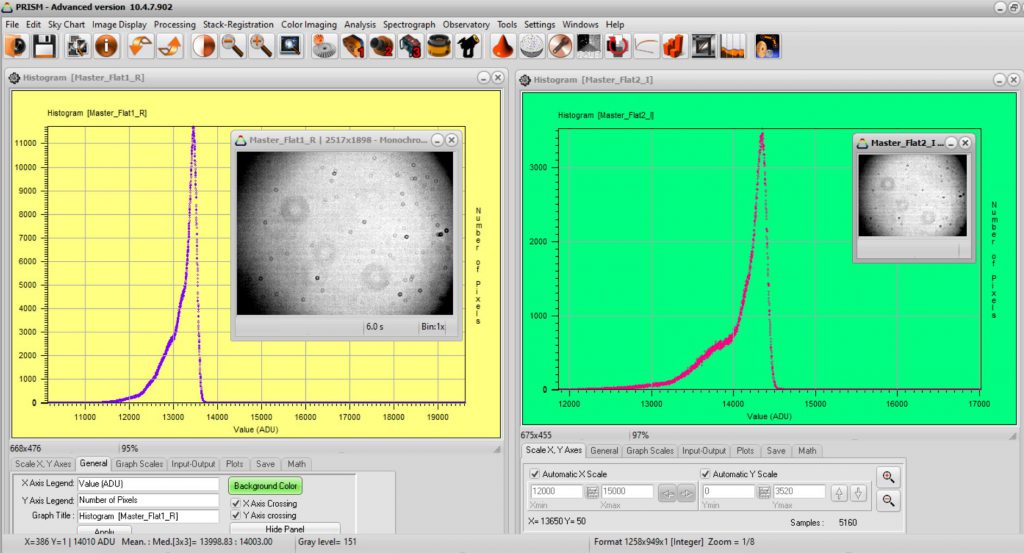We collected the empirical formulas for comet parameters a like Afρ, Water production rate Q(H2O), (molecules/sec), Dust production rate Q(dust)(Kg/sec) from standard papers and sources with due credits.
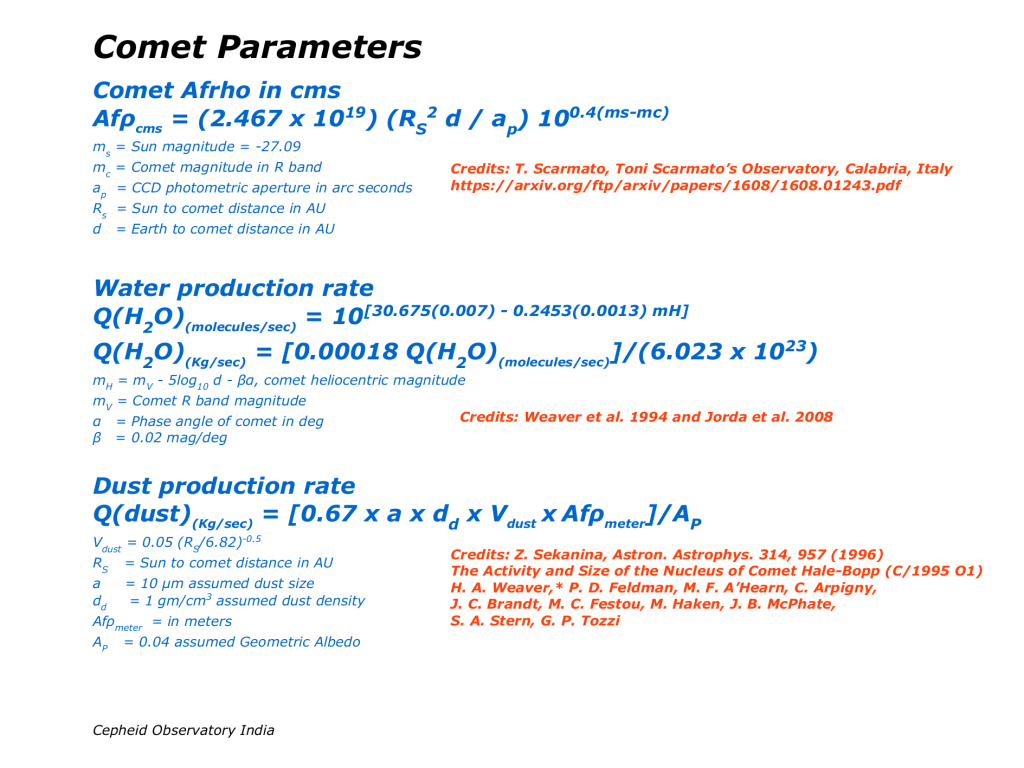
Link dedicated to the use of software used for photometry and spectroscopy of astronomical transients, AGN, Exoplanets, Nova, SN, comets and many more.
We collected the empirical formulas for comet parameters a like Afρ, Water production rate Q(H2O), (molecules/sec), Dust production rate Q(dust)(Kg/sec) from standard papers and sources with due credits.

Our friend, Willie Buning, Netherlands, provided the Gaia DR3 data within 30 Kparsec for bright star clusters (Globular as well as open clusters). The table generated by the python code developed by Joseph Karpinski. Willie modified the code a bit for plotting dominated bright star clusters in SQL or Excel. The spectral classification of stars inside clusters and their numbers presented in map. The image of Gaia DR3 map is shown below.
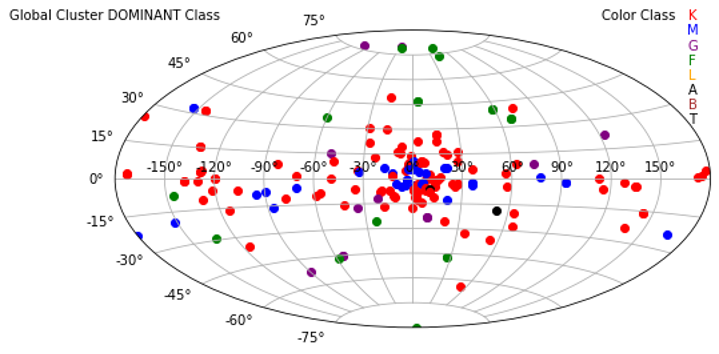
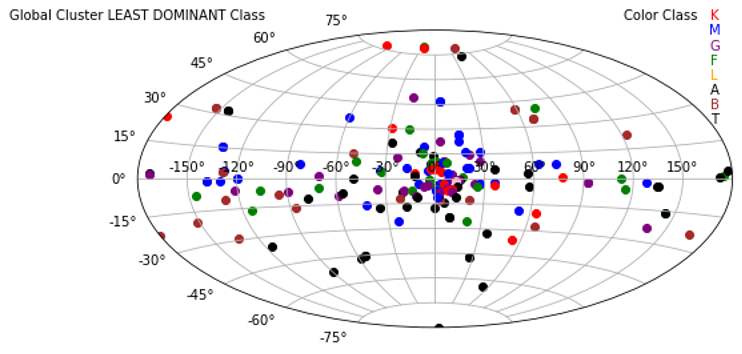
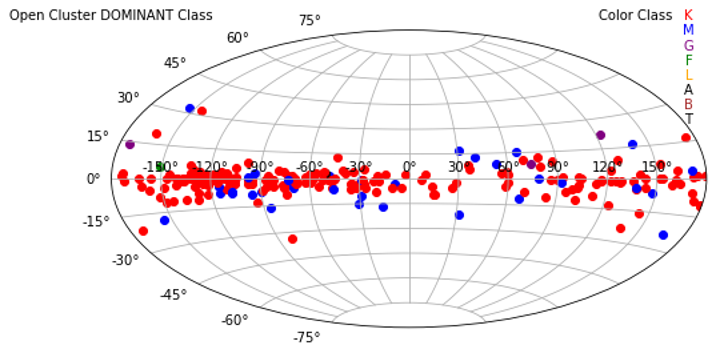
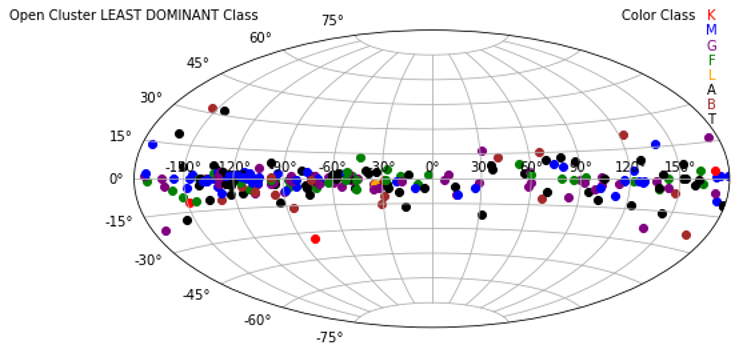
Best spectrophotometric standards:
epoch mu a cosd mu d Class V Mag
LTT377 00 41 02.9 -33 44 06 1985 f 11.2
Feige 24 02 32 30.9 +03 30 51 1950 +0.083 +0.010 DAwke 12.42
EG21 03 10 22.1 -68 39 28 1985 DA 11.4
G191B2B=EG247 05 01 31.5 +52 45 52 1950 +0.10 -0.0873 DAwk 11.78
GD71 05 49 34.79 +15 52 37 1950 + -0.1898 DA1 13.03
LTT2415 05 56 24.2 -27 51 26 1985 12.2
EG54 07 40 19.52 -17 24 41 2000 +1.136"/y -0.52" DF 12.98
LTT3218 08 41 33.6 -32 56 55 1985 DA 11.8
EG63 08 47 29.6 -18 59 50 2000 -0.12"/y -0.05"/y DB 15.55
LTT3864 10 31 33.1 -35 33 03 1985 f 12.1
Feige 34=EG71 10 36 41.1 +43 21 50 1950 sdO 11.24
GD153 12 54 35.21 +22 18 09 1950 -0.1898 DA1 13.35
HZ 43 =EG98 13 14 00.7 +29 21 49 1950 -0.149 -0.0813 DAwk 12.91
HZ 44 13 21 19.1 +36 23 38 1950 -0.062 +0.031 sdO 11.67
EG274 16 23 33.7 -39 13 48 2000 DA 11.0
LTT7379 18 36 26.2 -44 18 37 1985 G0 10.2
HD 192281 20 10 46.8 +40 07 01 1950 O5f 7.54
BD+284211=J256 21 48 57.1 +28 37 48 1950 sdOp 10.56
LTT9239 22 52 40.88 -20 35 26 2000 f 12.0
Feige110=EG158 23 17 23.5 -05 26 22 1950 +0.003 -0.003 sdO 11.88
OK standards:
Feige 25 02 36 00.0 +05 15 16 1950 B6V 12.01
Hiltner 600 06 42 37.2 +02 11 25 1950 B1V 10.42
Feige 56 12 04 13.8 +11 56 55 1950 B5p 11.11
Feige 92 14 09 41.3 +50 21 07 1950 Bp 11.62
BD+33 2642 15 50 02.9 +33 05 49 1950 B2 IVp 10.88
BD+40 4032 20 06 40.0 +41 06 15 1950 B2 III 10.45
The first set contains O stars without much Balmer absorption plus
faint southern standards from the list of Stone & Baldwin 1983, MN 204, 347.
The second set is mostly B stars that have a bit of Balmer absorption
and are usually OK.
from Link: https://www.cfa.harvard.edu/~dfabricant/huchra/standards.specp
The following graphs shows the conversion of flux densities w.r.t. magnitudes. The magnitude range is selected based on UCAC4 catalog from 0 to +16. The Y axis represents the energy flux in the units of (erg cm-2 sec-1 A-1) w.r.t respective U B V R I magnitudes. The graphs plotted both in Log and Linear scales.
Log Scale:
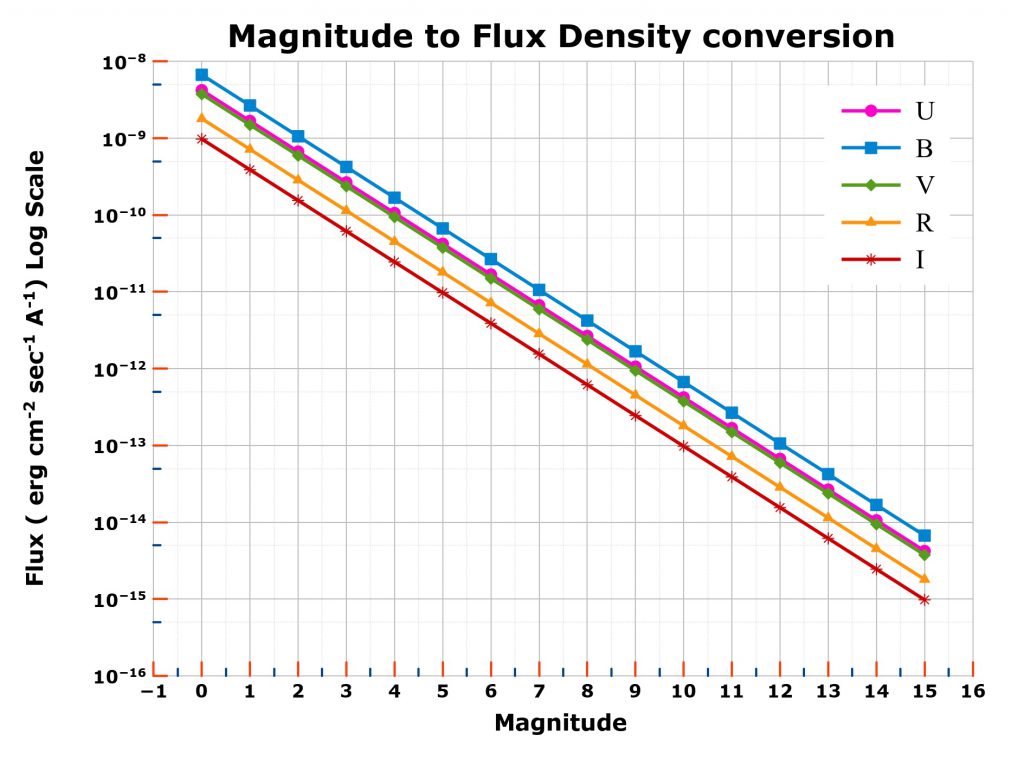
Linear Scale:
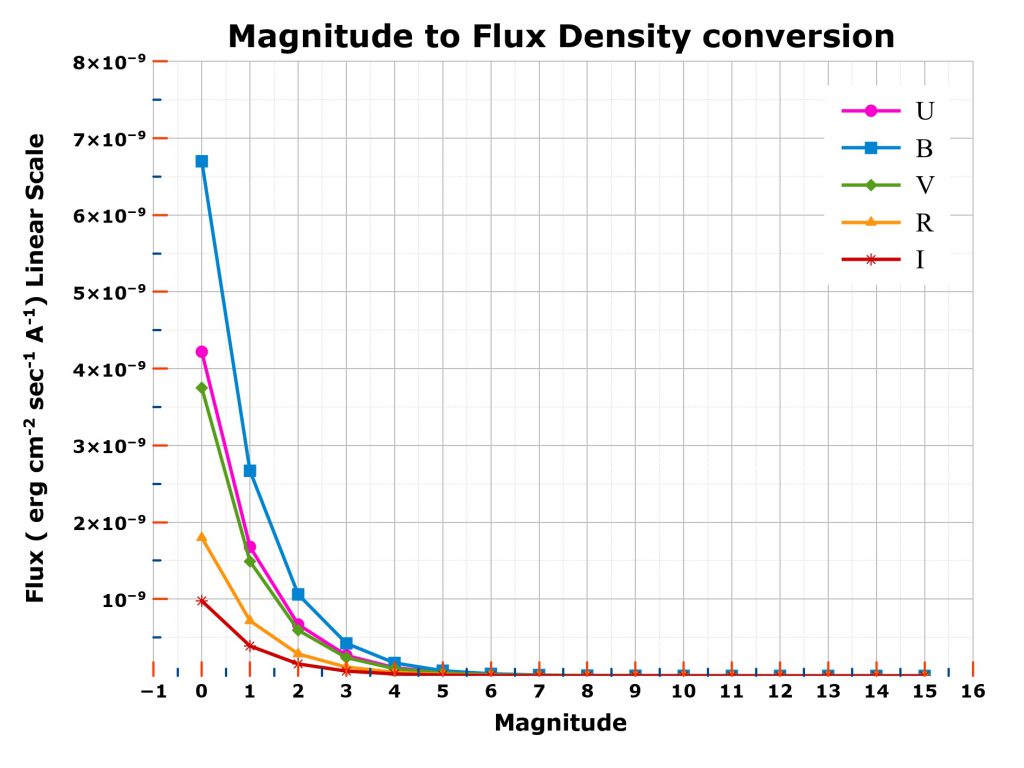

Here is Flux comparison of ISIS data and flux generated by NASA-IPAC tool (https://irsa.ipac.caltech.edu/…/data…/tools/pet/magtojy/) for Vega.Procedure is:1. Flux intensity drag of ISIS data using FIT files>>>then best fitting>>>then plotting w.r.t wavelength.2. Pickup flux intensity using star mag (NASA-IPAC tool) for UBVRI wavelengths>>>then interpolation of all wavelengths points similar to point no. 1>>>then best fitting>>>then plotting w.r.t wavelength. The flux intensity for UBVRI filters at central wavelength are mentioned in graph below.The star magnitude are taken from SIMBAD (but a better catalog may be used if available). In graph, we can compare that energy fluxes are almost similar from range between pointed arrows. The minor difference may be due of some off magnitude of star vega in SIMBAD database or fitting done.We see that fluxes deviate from 4200 A towards UV region. We assume that this is because of fall of CCD sensitivity (silicon band gap, works well from 400nm to 900nm and maintain same sign of slope (dF/dA). We think, this is the reason that, professional astronomers use V/R/I band filter response for absolute flux calibration. We did not find any document where U/B filters response were used for flux calibration. The change of slope of flux vs. wavelength may be a reason (not sure yet).But If We plot from 400nm to 700nm, We find both methods satisfactory. Science is fun!..![]()
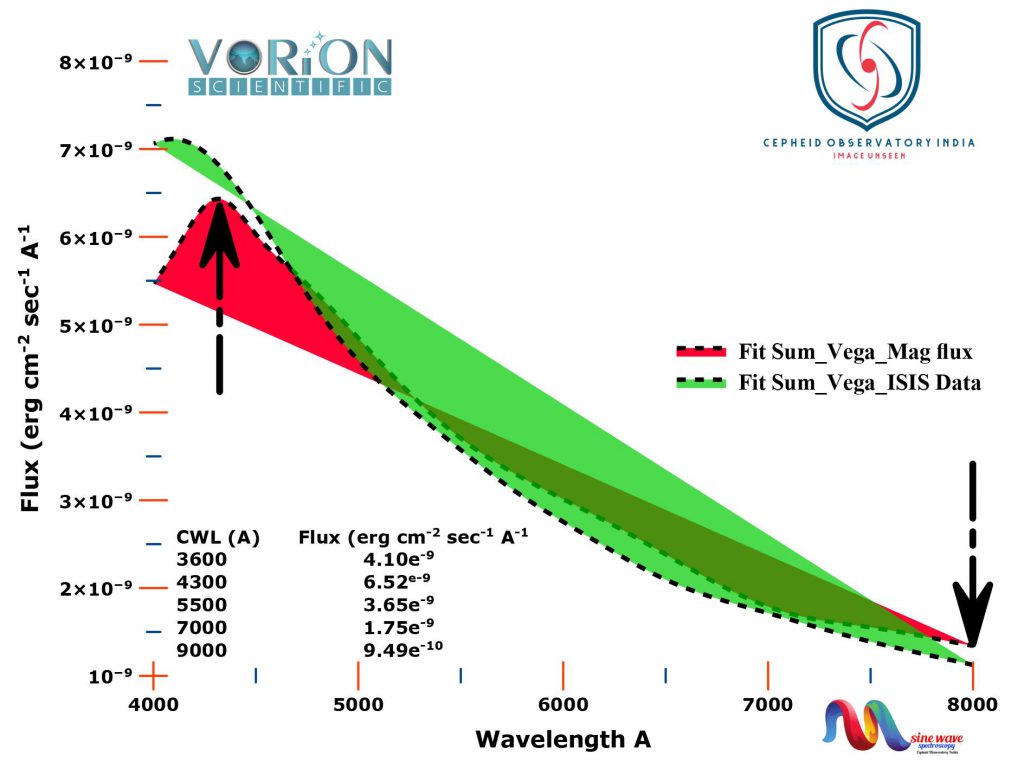
Flat Issues: Tried to analyze the flat frames using PRiSMv10. The CCD Atik383L+ have typical value of full electron well equal to 26,000. Set the diffuser to telescope (3 layered white cloth) and exposed for 1×1 bin and 2×2 bin for different time intervals to get ADU counts near to half of full well capacity. PRiSMv10 analyzed the ADU by plotting each pixel counts under menu: Analysis/Histogram/Global.
